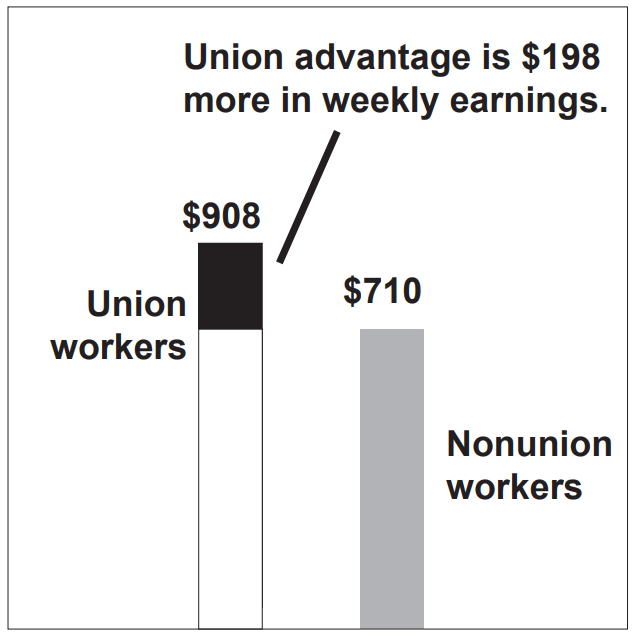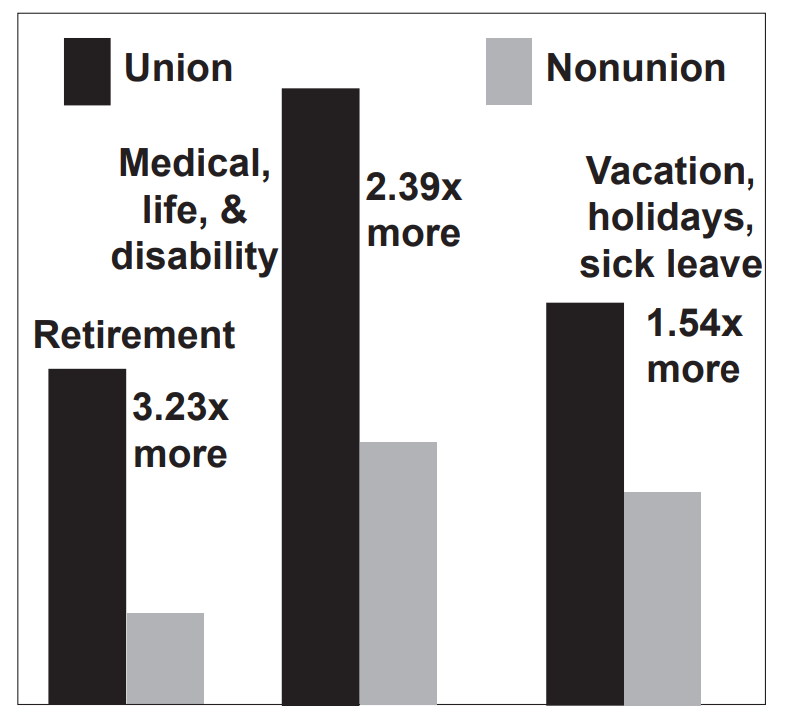Union members earn higher wages
In 2009, among full-time wage and salary workers, union members earned a median weekly wage of $908, while workers who were not represented by unions earned only $710 a week.
In 2009, among full-time wage and salary workers, union members earned a median weekly wage of $908, while workers who were not represented by unions earned only $710 a week.
This is the average wage for all industries and occupations in the United States. The union advantage may be higher or lower depending on your industry and occupation. However, union members always earn higher wages than nonunion workers. The only exceptions are managers and a few professionals such as architects and scientists.
Higher wages is only one of many benefits and advantages of having a union. Unionized workers have much better retirement and health care plans. Unionized workers have a contract which protects their rights on the job such as seniority, job security, a set work schedule, and more. Unionized workers have the power to negotiate with management to improve their conditions.
Don’t believe it when your boss says you’ll be better off without a union. You would lose much more than wages.
New York is the most highly unionized state, with 25.2 percent of their workers belonging to unions. Hawaii holds second place where union members make up 23.5 percent of the workforce. Alaska ranks third with 22.3 percent of their workers in unions, and Washington State is number four where union members are 20.2 percent of the workforce.

New York is the most highly unionized state, with 25.2 percent of their workers belonging to unions. Hawaii holds second place where union members make up 23.5 percent of the workforce. Alaska ranks third with 22.3 percent of their workers in unions, and Washington State is number four where union members are 20.2 percent of the workforce.
New York is the most highly unionized state, with 25.2 percent of their workers belonging to unions. Hawaii holds second place where union members make up 23.5 percent of the workforce. Alaska ranks third with 22.3 percent of their workers in unions, and Washington State is number four where union members are 20.2 percent of the workforce.
Better benefits can add $13,600 plus for unionized workers
Higher wages are nice, but unionized workers receive more and better benefits than nonunion workers. Benefits such as retirement plans, medical care, sick leave, vacations, holidays, and overtime pay can add up to a union advantage of over $13,600 a year more in total compensation for union workers.
Union workers receive medical and retirement benefits worth 2.6 times more than those provided to nonunion workers. This is a difference of $8,923 a year more for union workers. Nonunion workers usually have minimum medical coverage and little or no retirement benefits.
Union workers receive 1.5 times more vacation days, more holidays, more sick leave days, and more overtime and premium pay. This adds up to $2,700 more each year for union workers.
The cost of union and nonunion benefits shown here are for private employers of six industries--manufacturing; trade, transportation, and utilities; retail trade; transportation and warehousing; education and health services; health care and social services.
The average value of benefits received by union workers in the above industries was $28,870 a year, while nonunion workers received benefits worth $15,246. The union advantage in benefits was $13,624 a year for 2080 hours of work.
When you add wages and benefits, unionized workers in the industries listed above earned a total compensation package that was 155 percent higher than nonunion workers. This is $29,936 more a year for 2080 hours of work.
The US Bureau of Labor Statistics collects the cost of benefits for all industries in its National Compensation Survey. However, the survey only shows union and nonunion comparisons for the industries listed above. As a result, the data is slightly different from the BLS data on union membership.
See http://www.bls.gov/eci/ for more on the National Compensation Survey.

Theunionadvantageinbenefitsis189 percent higher than nonunion.
What is “At Will” employment?
In the United States, almost all workers who do not have an employment contract are “at will” employees.
An “at will” worker may be fired by their employer at any time and for any or no reason. This means a boss could wake up one morning and decide to fire the first employee he sees that day. This may be unfair, but it is perfectly legal under U.S. law.
The law only prohibits firing an employee where there is proof of illegal discrimination, such as race, sex, age, color, religion, disability, marital status, and sexual orientation. This list has grown longer as laws are passed to add other groups.
Unionized workers are protected by their union contracts, which require an employer to have good cause to fire them. Some executives and talented individuals such as actors, athletes, coaches, etc. may negotiate individual employment contracts. They can still be fired but the employer is usually required to pay a penalty.
Government employees have some protection where public policies and citizen outrage may limit what government managers can do.
All other workers in private business, about 95 million or 75 percent of the American workforce, are hired and fired “at will.”
Origins of “At Will”
The idea of “at will” first appeared in 1877 when Horace C. Wood wrote in Master and Servant that “a general or indefinite hiring is … a hiring at will” and can be ended at will by either party without liability.
Before the United States won its independence, it was a British colony. Many of our legal principles are based on British Common Law, where the law follows established customs or past practice. Under Common Law, a general hiring was for a term of one year, where the employer was obligated to employ a worker for one year and the worker was obligated to work for one year.
“At will” was a very different practice, where workers could quit at any time and employers could fire workers at any time.
American employers liked the power and control “at will employment” gave them over workers. Within a few years, “at will” employment spread throughout the United States.
In 1884, Mr. Payne opened a store that competed with the store owned by the Western & Atlantic Railroad Company. The railroad threatened to fire any employee who shopped at Mr. Payne’s store.
Mr. Payne sued, but the Tennessee Supreme Court ruled in favor of the railroad. The Court ruled that: “All may dismiss their employees at will, be they many or few, for good cause, for no cause or even for cause morally wrong, without being thereby guilty of legal wrong.”
This practice of “at will” employment remains the law in nearly every state in the U.S. today.
Workers rights protected
Most of the world rejected the idea of “at will” employment. Canada, England, and Europe have laws that protect workers rights and set minimum requirements for wages, working hours, paid leave, and other terms of employment. Where workers don’t have a union contract, many countries require employers to have individual contracts with each worker which cannot be less than the rights and benefits required by law.
Union workers have power to bargain
“Give a family a fish and they can eat for one day. Teach a family to fish and they can feed themselves everyday.”
Give workers a bonus and they will have a little more money to spend until the bonus is gone. Give workers collective bargaining through a union, and the workers will have the power to negotiate a wage increase every year.


